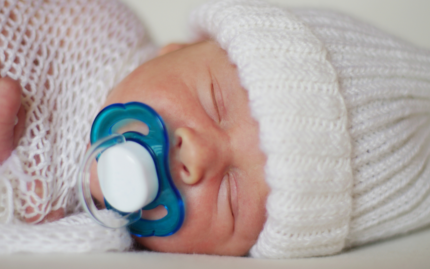Blog
How Long Should A Dummy Clip Be? A Must-Read Guide

If you’re wondering how long a dummy clip should be, the answer is simple — no more than 22cm from end to end. This isn’t just a suggestion — it’s a legal requirement in the UK designed to protect your little one from avoidable hazards like choking or strangulation.
In this guide, we’ll break down everything you need to know about dummy clip length, UK regulations, how to measure clips correctly, and the key safety standards to look for. Whether you’re buying one or making your own, it’s essential reading for every parent or carer.
Table of Contents
What’s the Maximum Legal Length for a Dummy Clip in the UK?
According to UK safety regulations, dummy clips must not exceed 22 centimetres in length. This measurement is taken from the bottom of the clothing clip to the end of the soother attachment — usually a silicone ring or loop.
Why exactly 22cm? It’s long enough to offer practical use (like keeping a dummy off the floor) but short enough to reduce the risk of it wrapping around your baby’s neck — a strangulation risk that’s too serious to ignore.
The 22cm rule comes from the BSEN 12586:2007+A1:2011 standard, which governs safety for soother holders. Always look for dummy clips that clearly mention compliance with this standard — reputable brands will make it obvious.
Not All Dummy Clips Are Created Equal
You’d be surprised how many dummy clips on the market don’t meet this standard. Some clips are advertised at 24cm or more — too long, and not legally compliant. No matter how pretty or well-reviewed they are, avoid anything that exceeds the limit. Safety should always come first.
At Dummy Clip, every one of our designs is handmade to meet this 22cm maximum — measured from clip to loop. We independently test our products to make sure they’re not only beautiful but genuinely safe for your baby.
How to Measure a Dummy Clip Correctly
If you’re buying from a handmade seller or making your own dummy clip, it’s vital to know how to measure it properly. Here’s how:
- Start from the bottom edge of the clothing clip
- Measure in a straight line to the end of the dummy attachment (not just the cord)
- Include beads, knots, rings — the full usable length must be 22cm or under
This applies whether the clip is made of silicone, fabric, wood, or a combination. Even a small excess in length could put your baby at unnecessary risk.
The Risks of Over-length Dummy Clips
There’s a reason the 22cm rule exists — and it’s all about reducing serious risks:
1. Strangulation Hazard
If a dummy clip is too long, it can wrap around your baby’s neck during movement or sleep. This is especially risky once babies start rolling, crawling, or pulling at things. Never leave a dummy clip attached when your baby is sleeping — even if it’s the right length.
2. Choking Risk
Babies chew. It’s what they do. If your dummy clip has beads, silicone shapes, or plastic parts, they need to be securely fastened and made of non-toxic, baby-safe materials. Any weak point could break off and become a choking hazard.
What Safety Standards Should a Dummy Clip Meet?
In the UK, all soother holders must meet BSEN 12586:2007+A1:2011 — that’s the gold standard. This includes:
- Maximum length of 22cm
- Secure attachment clips
- Non-toxic, durable materials
- No sharp edges or small detachable parts
Depending on the design, CE and UKCA markings may also apply — particularly for clips that have “play value” (think bright colours, character charms, or interactive textures). These are legally considered toys and must meet additional testing requirements.
Top Tip: If a seller is only providing Chinese or generic certificates, proceed with caution. UK testing is a separate process, and you’re well within your rights to ask for proof of UK-based safety testing.
What Materials Are Safe for Dummy Clips?
Here’s what to look for in a high-quality, baby-safe dummy clip:
- Food-grade silicone – soft and safe for teething
- Natural, untreated wood – smooth and chemical-free
- BPA-free plastics
- OEKO-TEX certified fabrics
- Lead- and phthalate-free finishes
If you’re buying a beaded dummy clip (like our bestselling Daisy Clip), make sure the beads are tightly knotted and can’t come loose. We use double-knotting between beads and test tension points before anything goes out the door.
When and How to Use Dummy Clips Safely
Even with a compliant clip, proper use is key. Here’s our quick checklist:
✅ Always supervise your baby while using a dummy clip
✅ Remove during naps and overnight sleep
✅ Never add extra length or tie extensions
✅ Attach securely to clothing — not bibs, blankets, or loose fabric
✅ Inspect regularly for damage, wear or loose parts
✅ Clean according to instructions — some parts like wood should never be soaked
✅ Replace at signs of wear (or every 3–6 months with daily use)
Choosing a Safe Dummy Clip: What to Look For
When you’re shopping for a dummy clip, here’s what matters most:
- ✅ 22cm or under – No compromise here
- ✅ Clear compliance with BSEN 12586
- ✅ Safe, baby-friendly materials
- ✅ A design suitable for your baby’s age & stage
- ✅ Easy to clean and maintain
Of course, we know you want it to look cute too — and that’s totally possible without compromising on safety. From neutral tones to pastel pops, our handmade clips are designed to match your style and pass safety with flying colours.
Final Thoughts: Keep It Short and Safe
A dummy clip should never be longer than 22cm, full stop. That one measurement can make a massive difference in protecting your baby from unnecessary risks.
As parents ourselves, we created Dummy Clip to blend practical safety with beautiful design. Every clip is handmade in the UK, tested to the latest standards, and created with total peace of mind in mind.
For more safety tips, check out our Dummy Clip Safety Hub, or browse our full collection of certified dummy clips here.



